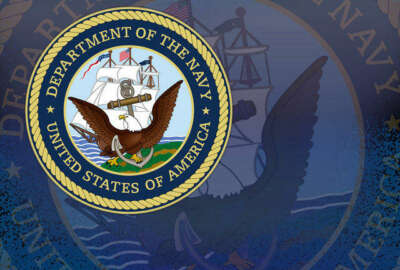Since the end of World War II, the Office of Naval Research has been the Navy’s main mechanism for combining talent and technology from government, academia and industry to turn out cutting-edge capabilities that are then deployed throughout the fleet.
The system works well, according to the current chief of Naval research. Its main problem is it’s too slow to keep up with modern threats.
Rear Adm. David Hahn, who took the helm of ONR in November, said that’s beginning to change with the development of new framework for how the Navy administers the science and technology enterprise – including how new research is applied throughout the fleet once a new breakthrough is achieved.
“We need to get our applied research into a demonstration forum so that folks can kick the tires, start using it in the environment it’s intended to be used in,” Hahn said during an interview for Federal News Radio’s On DoD. “Then it’s got to get pulled all the way through into a program of record – the set of organizations and vehicles by which we get technologies, at scale, onto ships or submarines or into the hand of a sailor or Marine. We’ve got to bring that whole activity set forward as fast as technology allows, not as fast as our bureaucracy allows.”
Hahn said the overarching goal is to organize the Navy’s acquisition processes so that they’re “impedance matched” with the rapid development pace of the technologies it’s trying to procure and behaves with a sense of urgency.
In the early months of the effort, he said ONR has started a reassessment of all of its research portfolios to make sure their objectives are both clearly communicated, and not so narrow as to miss out on potential breakthroughs its researchers may not be thinking about today.
ONR is also working to build tighter relationships with the acquisition program offices that actually procure and field equipment to the fleet.
“We have to make sure that as we move from early stages of research into the applied world that we’ve got good connectivity with our catchers while we’re pitching ideas,” Hahn said. “It has to be done so the product can find an on-ramp into a fielded system; it’s got to get on a merge lane so that it can be integrated smoothly without being disruptive to our own programs. At the same time, we have to meter these things in a way that the sailors and Marines who have to use them can absorb them, because there’s always a training load at the back end of these innovative ideas, and frankly, technology can overwhelm them if you try to move things too fast.”
And to gather more of those innovative ideas at the front end of the technology development process, the Navy is trying to broaden its search for new technologies beyond its traditional research and industrial base.
In an initiative ONR calls the Concept Challenge, the organization is asking literally anyone who believes they have an idea for a technology that could help the Navy and Marine Corps deter conflict and win wars to submit one-page summaries for possible adoption into ONR’s research portfolio.
Submissions are due June 30, and Hahn plans to announce the finalists at the Naval Future Force S&T Expo in Washington on July 20. He said the criteria for the challenge is broad, by design: candidates could include anything from a brand new technology the Navy has not yet examined to new ways of combining existing systems that fit into future war fighting concepts.
“Anytime you can bring more human beings into the mix, you’re going to get a better answer,” he said. “Our workforce is the best that you can find in the world, but anybody’s thinking can get stale. So by bringing this broader approach to bear, I think we can tune our sense of what’s possible a little bit differently, see where technology’s going a little more quickly, and be first to market.”
Copyright
© 2024 Federal News Network. All rights reserved. This website is not intended for users located within the European Economic Area.
